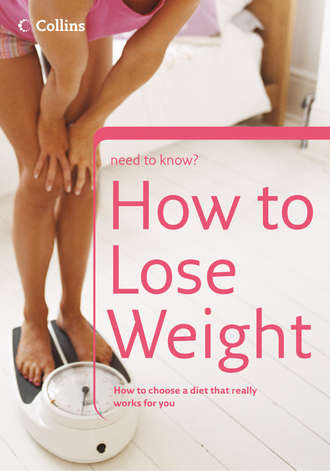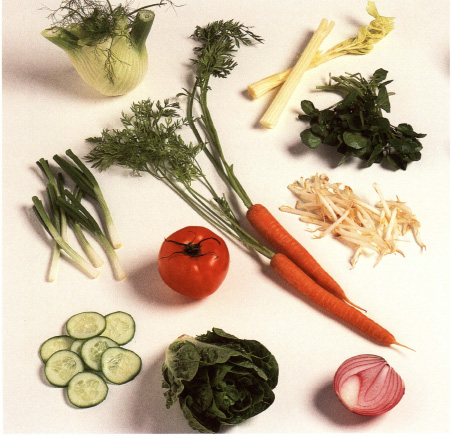
Полная версия
How to Lose Weight
must know
Fast food
It’s official: fast food causes weight gain. A 15-year study in the US showed that people who ate at fast food restaurants more than twice a week gained an extra 4.5 kg (10 lb) compared to those who ate fast food less than once a week.
A NEAT trick
Scientists are also excited about the way that we move and use energy when we’re not consciously exercising: a process they call Non–Exercise Activity Thermogenesis (NEAT). Studies at the Mayo Clinic in Minnesota, USA, have shown that obese people expend fewer calories in all areas of daily life than slim people; they sit still for longer periods and even fidget less. Researchers estimate that slim people could ‘naturally’ burn up to 350 calories more per day in this way than overweight people – the equivalent of a 30–minute run. When slim volunteers were overfed so that they put on weight, their energy output remained the same, however, suggesting that the overweight people were not being lazy’: there is a bio–chemical process at work that predisposes them to be less active.
While it may take years to identify exactly how and why this happens, it is further evidence that making activity an everyday habit is key to losing weight and staying slim –wherever you start on the road from completely sedentary to fighting fit.
Eating for two
A 2005 survey of 2,000 new mothers found that nearly two years after giving birth, their average weight was a stone heavier than they had been before their pregnancy. Of course, putting on some weight is expected and desirable in pregnancy. However, many women who have never had a weight problem find that the pounds pile on and then prove very hard to lose long after their baby is born – so much so that they despair that pregnancy has somehow changed their natural weight forever. The reassuring news is that there seems to be no fundamental, physical reason why this should be the case. It appears more likely that any weight gain is a side-effect of the upheaval in lifestyle that can come with the arrival of a new baby: lack of sleep, snatched meals, no time for exercise and more time spent at home can all alter the energy balance sufficiently so that weight goes on and stays put.
Monitoring your weight in pregnancy and not ‘eating for two’ so that you do not gain too much is sensible; around 13 kg (28 lb) is an average amount. Breastfeeding is good for the baby and for you, as it uses up around 500 calories a day. Crash diets and intensive exercise are not the way to regain your pre-pregnancy shape, whatever you might read in celebrity magazines. Instead, go for a slow and steady weight loss, with a healthy diet and gradual increase in activity, and aim to lose any surplus pounds over a period of months rather than weeks.
It’s my age
Is it inevitable to gain weight as we get older? Surveys suggest that we are at our heaviest in our 40s and 50s, and that the main reason for this is that we become gradually less active, rather than eating more. One large research project found that most adults will gain 9 kg (20 lb) between the ages of 20 and 55 years unless they take specific steps to avoid it.
So eating as if you are still playing football twice a week, when these days you are watching it on television twice a week, is a relatively effective way to score an own-goal as far as your weight goes.
must know
Drugs and medication
Weight gain can be a side-effect of some drugs and medical treatments. These include cancer drugs, such as tamoxifen; some steroids and antidepressants; and some drugs for diabetes and epilepsy. Ask your GP about the side-effects of any medication you are prescribed and whether you need to be careful about your diet while you are taking it.
The menopause
Women going through the menopause often feel they have more trouble managing their weight and may accept gaining the ‘menopause 10’ as an inevitable side-effect. However, as with pregnancy, that other major hormonal event, research suggests that the menopause does not necessarily lead directly to weight gain, although increased levels of testosterone and decreased levels of oestrogen may mean that the distribution of weight will change slightly, so that ‘pear’ shapes become ‘apples’ – the classic middle-age spread.
As we saw earlier, carrying excess weight around the waist represents a higher risk of developing health problems than on the hips and thighs, so it is well worth aiming to get your weight into the healthy range and your waist below 80 cm (32 in).
want to know more?
Take it to the next level. . .



Other sources






4 The science of weight loss
Understanding the energy equation and how to alter it in order to promote weight loss instead of weight gain is the key to reaching a healthy weight. Knowing the facts can be the basis of taking control of your weight and staying motivated throughout a safe and steady weight loss campaign.
The energy balance
The last section looked at the energy equation and the different factors that can affect it. Now the time has come to apply those principles to individual circumstances.
must know
Calories
One calorie (4.2 joules) is the amount of energy required to raise the temperature of 1 gram of water by 1 degree Centigrade. Nutritionists measure the calorie values of foods by burning them in a calorimeter to see how much heat they give off. The major food groups differ in ‘energy density’ –the number of calories they contain per gram:




Altering the energy balance
The next few pages set out how far to reduce your calorie intake and increase your calorie output in order to create your own personalized slimming plan which will guarantee safe and steady weight loss.
As the previous chapter showed, the science behind weight loss and weight gain is all about the energy equation: consuming more energy, in the form of food, than is expended in activity results in weight gain. To lose weight, it is essential to create an ‘energy deficit’ so that more energy is expended in activity than is taken into the body as food.
Units of energy
The units of energy used to measure this process are kilojoules or calories – the word that can be very off-putting for people who have followed the kind of diet that requires the counting and measuring of every single mouthful they consume. Unfortunately, it is impossible to ignore calories when trying to lose weight. It is true that there are plenty of diets that promise you ‘need never count another calorie’. This is generally because they either give calories another name, such as ‘units’, or because they ensure that calorie intake is controlled automatically by limiting the kinds of foods that can be eaten.
Calculating your energy deficit
The aim of this section is to show you how to calculate a personalized energy deficit by working out:



Inevitably, this means talking about calories. However, it is possible to lose weight easily by being calorie-conscious and without having to become a calorie slave
must know
Calorie guides
Buy a calorie counter book for an at-a-glance guide to thousands of everyday foods. These are available at most newsagents and bookshops. Don’t guesstimate!

Bulky, watery foods like salad vegetables make good low-calorie fillers in a slimming diet.
must know
Diet or exercise?
When thinking about losing weight, men and women tend to have different approaches: women say it’s ‘time to start the diet’ and men say it’s ‘time to hit the gym’. It is perfectly possible to create an energy deficit by changing your diet alone, or just by doing a lot more exercise (although the exercise-only route is slower). The perfect combination for health and weight loss is to do both: to make some small changes to your diet, and to become a bit more active as often as possible.
Where does it all go?
The body uses the food we eat in three main ways: for growth; to replace damaged or worn-out tissues; and to fulfil all the body’s daily functions, which can range from breathing to ballroom dancing. The amount of energy needed from food to keep the body going, without gaining or losing weight, is called the basal metabolic rate (BMR). Any energy (calories) which is taken in over and above the requirements of the BMR is stored – and, as the last chapter showed, this is one thing at which the body is very efficient.
Once food has been digested, any surplus energy is stored either as glycogen – a short-term energy source, which is stored in the liver and the muscles – or as fat, which is stored in ‘fat depots’ under the skin, around the kidneys and in the abdomen. There is a limit as to how much glycogen can be stored before it is released back into the bloodstream to be used, but there is no limit to the amount of fat that can be stored. Fat cells get bigger, multiply and form adipose tissue which can eventually present a threat to our health.
It takes about 3,500 calories surplus to the requirements of the BMR to create 1lb (454 g) of stored energy (otherwise known as fat). So an individual whose BMR is 2,500 calories per day, and who eats 3,000 calories’ worth of food per day without changing his or her activity level in any way, could expect to put on a pound a week (7x500 = 3,500 calories). In practice, our body weight fluctuates from day to day and even at different times of the day, which is why it is best to weigh yourself only once a week at the same time –jumping on the scales more often can be misleading. However, overtime, a steady over-supply of calories without an increase in activity to compensate will surely result in a weight gain.

Healthy home-grown vegetables: fantastic for taste, freshness and providing valuable nutrients.
And in the same way, creating an energy deficit, so that more energy is expended than the BMR requires, will equally surely result, overtime, in weight loss. So, again, someone whose BMR is 2,500 calories and who eats 2,000 calories’ worth of food each day could expect to lose a pound a week.
Find your balance
There are four steps to working out your basal metabolic rate (BMR):
1 Assessing the resting metabolic expenditure (RME).
2 Making an allowance for activity.
3 Adding in 10 per cent for the energy used in digesting food.
4 Totalling it all up.
As you will see from the instructions and the example given below, this is much easier than it sounds.
Step 1
Use the table to read off your RME. The differences in the table are accounted for by gender and age: generally, men need more calories than women to maintain their weight because they have a higher percentage of muscle tissue, which burns fuel more efficiently than fat. Age is a factor, too, because the amount of energy the body needs for maintenance peaks at the age of about 25 and declines gradually after that, at a rate of about two per cent per decade.
Your RME
Age – Men RME equation 18–30 15.3 x weight (kg) + 679 30 –60 11.6 x weight (kg) + 879 60 and above 13.5 x weight (kg) + 487 Age – Women RME equation 18–30 14.7 x weight (kg) + 496 30 –60 8.7 x weight (kg) + 829 60 and above 10.5 x weight (kg) + 596Step 2
Factor in your activity level, based on what you normally spend most of the day doing. The guidelines and calculation are as in the table opposite (top).
Multiply your RME from Step 1 by the activity factor to find the number of calories needed for activity each day.
Your activity level
Usual daily activities Activity Level Activity Factor Desk job or light housework; driving; reading; watching TV Very light 0.2 Childcare; light exercise, e.g. walks; moderate housework; light manual work, e.g. mechanic, waiter Light 0.3 Moving about all day; spring-cleaning; heavy gardening; active sports Moderate 0.4 Heavy manual work, e.g. building, digging high-energy sport, e.g. football Heavy 0.5Step 3
Add together your RME figure and your ‘activity calories’ figure and divide by 10 to find the calories needed for digestion.
Step 4
Add together your RME figure, ‘activity calories’ figure and ‘digestion calories’ figure in order to find your BMR (basal metabolic rate) – the total number of calories that are needed each day to maintain your weight.
To lose weight steadily, the best combination is to reduce your calorie intake and to increase your calorie expenditure by making changes to your daily diet and activity levels.
must know
Working out BMR
Jane is a 30-year-old mother of two with a part-time office job. She weighs 76 kg (12 stone).




Keeping a food diary
Having worked out how many calories you need to maintain your current weight, the next step is to work out how many calories you are taking in as food. Nutritionists recommend that the best way to do this is to keep a food diary. To get a full picture of calorie intake it is important to keep the diary for at least a week, or longer if you feel it would be helpful. Keeping a food diary sounds easy but, in practice, researchers have found that people who are asked to record their food intake almost always under-report what they actually eat. However, to identify patterns of where calories are coming from and where easy savings can be made, it is important to be as detailed and honest as possible – after all, no one else will see the diary. It is also important to eat and drink exactly as usual and not to change your normal routine in any way, as you need to keep track of all the occasions during the week when you might have an opportunity to save calories.
must know
Calorie savings
Look over your food diary to identify the areas where it would be easy for you to make calorie savings.
Sample food diary for a single day
Breakfast
Med egg, 2 rashers back bacon, 1 tbsp vegetable oil, 2 slices white toast, 2 tsp butter, 200 ml glass orange juice, 2 cups tea, whole milk, 2 sugars
Lunch
100 g chicken, 15 cm baguette with 1 tbsp mayo, 25 g packet plain crisps, apple, 2 cups tea, whole milk, 2 sugars
Dinner
225 g grilled rump steak, 225 g jacket potato, 1 tbsp butter, 2 tbsp poached mushrooms, 1 grilled tomato, medium bowl strawberries, 2 tbsp double cream
Snacks/drinks
2 cups coffee, whole milk and 2 sugars; 2 chocolate digestives; 2 x 175 ml glasses red wine; 1 glass water
Total calories per day: 3,048
At this pre-weight loss stage your aim is just to observe everything you eat and drink over the diary period. You are not trying to lose weight – not yet anyway. The example shows the level of detail that is required.
Food diary rules



Identifying calorie savings
After a few days of diary keeping it may well be that eating patterns can be seen more clearly, so that it is possible to see ways of reducing your calorie intake by swapping to lower-calorie, lower-fat foods or by reducing portion sizes. For example, from the diary it can be seen that the day’s intake is high in sugar and in full-fat products, such as butter, milk and oil. The table below shows just how many calories could be saved by swapping to different varieties:
Swap this.. For this. . . Calorie saving 12 tsp white sugar 12 tsp sweetener 192 300 ml whole milk 300 ml skimmed milk 90 2 tbsp double cream 2 tbsp light single cream 96 1 tbsp vegetable oil 10 sprays one-cal oil spray 125 2 X 175 ml red wine 1 X175 ml red wine 120Making the swaps shown above would save 623 calories in a single day –without having to make any noticeable changes to the diet. Some people will find that there are easy, daily calorie-savings they can make in their diet, whereas others may identify regular but not daily occasions –such as a weekly takeaway or a night out –where big calorie-savings can be made at a stroke. This is why it is important to keep the food diary for as long as it takes to establish a pattern.
must know
Average intake
At the end of the diary period, the average daily calorie intake can be worked out by adding up the daily totals and dividing by the number of days. To do this, it is worth investing in a comprehensive calorie-counting guide which has thousands of food products, including branded ones.



